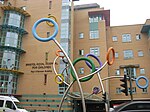St Mary Magdalen Nunnery, Bristol
1173 establishments in England1536 disestablishments in EnglandAugustinian nunneries in EnglandChristian monasteries established in the 12th centuryFormer buildings and structures in Bristol ... and 1 more
Monasteries in Bristol
St Mary Magdalen Nunnery (grid reference ST585733) was a priory of Augustinian canonesses in Kingsdown, Bristol, England. It was founded c. 1173 and dissolved in 1536. St Mary Magdalen is remembered in the name of Maudlin Street; the nunnery was located near to the corner of Maudlin Street and St Michael's Hill, which was later the site of the King David Inn.
Excerpt from the Wikipedia article St Mary Magdalen Nunnery, Bristol (License: CC BY-SA 3.0, Authors).St Mary Magdalen Nunnery, Bristol
Saint Michaels Hill, Bristol City Centre
Geographical coordinates (GPS) Address Nearby Places Show on map
Geographical coordinates (GPS)
| Latitude | Longitude |
|---|---|
| N 51.45719 ° | E -2.59782 ° |
Address
Saint Michaels Hill 2
BS2 8DT Bristol, City Centre
England, United Kingdom
Open on Google Maps









